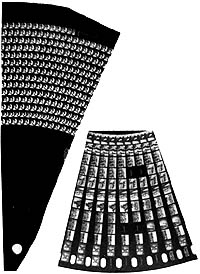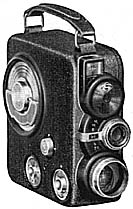Edison's Kinetoscope, invented in 1889 and then only a peep-show (the Lumieres were thus first with a "real" movie show) had made 35 mm a de facto standard width almost immediately, and it has remained so ever since. (The Lumieres did use another type of perforations, but anyway...)
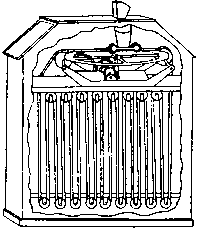 Edison's peep-show "Kinetoscope", 1894
Edison's peep-show "Kinetoscope", 1894
Why 35 mm? Legend has it that when Edison was asked by his workers how wide to cut the film (which was manufactured by the Eastman company), he held up his thumb and forefinger and said "About this wide"... More probable, however, is that the 35 mm width was derived by just slitting in half the readily available 70 mm wide Eastman roll film (unperforated, used for still-pictures).
Edison subsequently perforated the slitted film with 4 rectangular perforations on each side of the image frame, which originally was 18*24 mm (approx. 3/4" * 1") in size. Today, the optical sound track needs some of the film's width (there is often also a digital sound track between the perforations), and due to the the different wide screen aspect ratios, not all of the available height is used (see my "Image Areas" page).
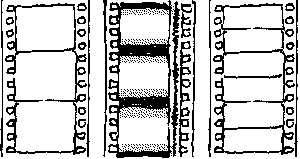
Left: 35 mm film, as invented by Edison in 1889's.
A frame from one of the very first of the Lumiere films, "Watering the Gardener", 1895. Note how the perforation differs from Edison's - only two round holes per frame.
Middle: The image size had to be reduced when an optical sound track was added in the late 1920's. Note the thicker frame lines (black), a significant loss of film area. When projecting in wide-screen, even more is lost (dotted).
Right: Some 35mm cameras in use today have been modified to shoot a 3-perf or 2-perf ("Techniscope") widescreen size on 35mm film, as opposed to the original 4-perf size. This saves some film during the original shooting, but necessitates special re-printing of the film for theater release.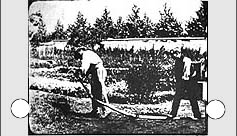
One of the first to slit ordinary 35 mm film to use in a 17.5 mm camera was the Englishman Birt Acres, who already in 1895 used his new "Birtac" format to record the famous yearly rowing competitions between the British universities. His camera was also used as a printer and projector. So was the German Ernemann "Kino", one of many 17.5 mm formats with center perforations. Very similar to this were both the British Wrench & Son "Biokam" and the Hughes system, which also provided the users of their system with ready-made entertainment films.
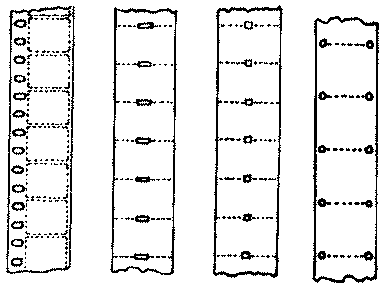
From left: "Birtac", "Biokam", "Hughes" and "Clou" 17.5 mm films.
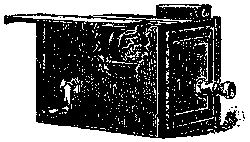
The Birtac camera
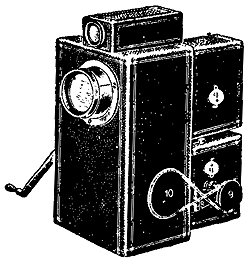
Ernemann's Kino camera
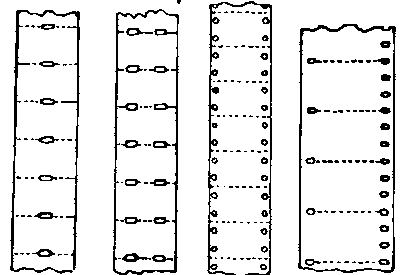
17.5 mm "Ernemann", "Duoskop" and "Movette" formats.
Right, the 28 mm wide Pathé film.
The American "Movette"-format, manufactured in Rochester, also utilized 17.5 mm film, but it had 4 round perforations per frame, 2 on each side of the frame. The somewhat bulky camera had its lens on the wide side of the camera box. Here, there were two different contraptions for recording and presenting the movies, a camera and a projector - most formats still used the same mechanism for both functions, by just adding a lamphouse to the camera.
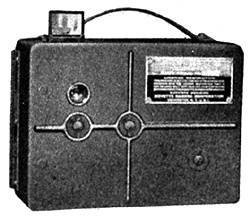
The Movette camera
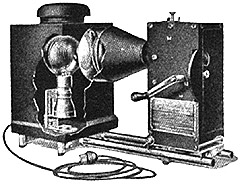
Movette's projector
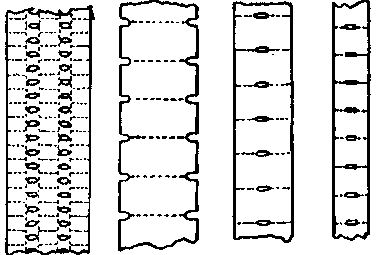
22 mm Edison film, 21 mm notched Mirograph,
15 mm Gaumont and the popular 9.5 mm Pathé "Baby" film.
In 1900, the French company Reulos, Goudeau & Co. introduced their "Mirograph", which used a 21 mm wide film with edge notches instead of perforations. This must have been very prone to film breaks! Another French format, by Gaumont & Co., introduced a 15 mm wide center-perforated film and camera, the "Pocket-Chrono".
However, the real breakthrough for amateur movies didn't arrive until the advent of the fireproof "acetate" film. The "nitrate" type film used for 35 mm (and most derivations of split 35 mm) was extremely flammable - in fact, the main ingredient in nitrate film is chemically identical to "smokeless gunpowder", which also is made from cellulose nitrate, albeit without the softening agents that make the film flexible enough for motion picture use.
| If you have nitrate film in your possession, be extremely careful! It is NOT to be played with! I have met people who have lost fingers, a whole hand or an eye when fooling around with nitrate film. Many have died in explosion accidents or fires - water won't extinguish a nitrate fire! You can best identify nitrate by taking a VERY small piece (no more than one frame) FAR AWAY from the roll (into another room, or even outside the house, please, and over a surface that won't ignite if the film piece is dropped or melts), hold it with pincers (NOT in your hand!) and ignite it with a match, far away from your face. If it burns briskly with a bright yellow flame, it's nitrate. If it only melts and smokes, it's "safety" acetate film. WARNING: Be careful, and don't ignite more than one frame - in larger quantities, nitrate film burns explosively! NOTE: When nitrate film ages, it starts to decompose BY ITSELF, and becomes even more flammable. There are instances where such film has spontaneously ignited and even exploded. If you have some old film that seems to be getting powdery, or sticky, or starts smelling strongly, you may have on hand a roll of self-decomposing nitrate. Contact your fire dept. immediately for further instructions. Nitrate film in good condition should only be stored by a proper film archive, not in a home. Contact an archive in your area. They may even wish to preserve your film by copying it to a safer media! |
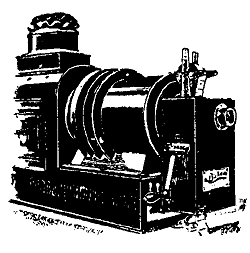
The "Biokam" camera became a projector when attached to a lamphouse.
The "Mirograph" camera.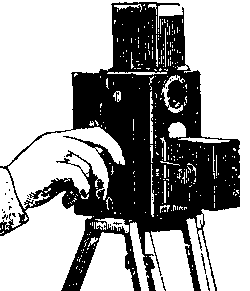
|
Film widths are always metric, but here are a few measurements in inches: 35 mm = 1.378" 17.5 mm = 0.689" 16 mm = 0.63" 9.5 mm = 0.374" 8 mm = 0.315 " |
Around 1922 Pathé introduced the 9.5 mm "Pathé-Baby" camera, projector and film stock. This was the first format to find wide acceptance, mostly because of its lower cost. One reason for this was that the film was reversal-processed, i.e. the original film was processed to a positive image, and did not have to be (expensively) printed in order to be projected. Pathé also printed many 35 mm films to 9.5 mm, and rented these to the public. Instant success!
Almost at the same time as the 9.5 mm format was launched, Kodak introduced their 16 mm format, and most manufacturers adopted this size, normally provided on 100 ft/30 m daylight loading spools. It was, however, more expensive to use than 9.5 mm, which survived for quite some time because of its lower cost. 16 mm was orignally intended just as an amateur format (it was even available in drop-in loading magazines, holding 50 ft/15 m). But being ideal for educational, industrial, and later TV purposes, it soon became a professional format, with darkroom loading camera-specific cassettes, taking 400 ft/120 m of film wound only on cores.
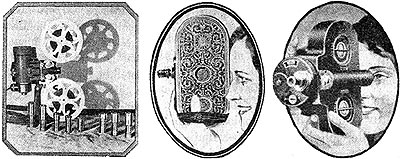
Bell & Howell 16mm "Filmo" projector and cameras from the late 1920's. Note the elaborate decoration on their simplest camera... perhaps this movie camera was designed with the female users in mind?
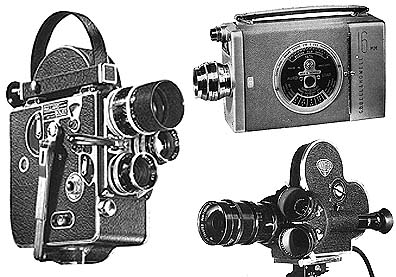
Left: an early version (approx. 1950) of the ubiquitous Bolex H16 camera, a reliable, spring-wound workhorse used on top of Mount Everest, in the Antarctic as well as in the Sahara desert... It is still available today in both spring-wound and electric versions. Right: Bell & Howell's cassette-loading amateur 16mm camera and a professional Arriflex used for TV programs and documentaries.
On the projector side, there were dozens of models available, from inexpensive, hand cranked amateur models, all the way to professional machines provided with arc-light lamphouses for movie theater use.

The French "Pathé Webo" camera was available in both 9.5mm and 16mm versions, the latter shown here.
 | In the 1980's, a new format, "Super-16" was derived (for camera use only, prints are made on 35 mm or video) by utilizing the sound track area of standard 16 mm for the image. This area had originally, in the silent era, carried a second row of perforations. So it was possble to enlarge the frame size in the horizontal direction, making it more compatible with modern movie theater screen sizes and the HDTV standard (which hasn't really found its market yet). This is a S-16 negative clip - the image area is 12.35 mm wide and 7.49 mm high. When blown up to wide-screen 35mm, almost the whole area is used, an enormous improvement over regular 16 mm, where a large portion of the height of the image is wasted in a blow-up. More about Super-16 on my other pages: S-16 modification, Image areas, Finder reticles. |
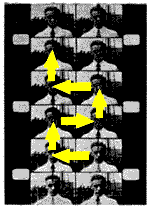
Kodel's incredible zig-zag film movement.

The original, double-perforated 16 mm film lost one row of perforations when a soundtrack was added. The Bell&Howell projector shown here was common in schools & industry in the 1960's. I was at that time the "movie nerd" in my class, and ran many, many shows with this projector.
Kodak dominated the sub-35 mm market with its 16 mm Kodachrome, but this was still too expensive for "everyman". Experiments with images smaller than16 mm had been made by the Kodel Electric & Manuf. Co. in Cincinnati, which used ordinary 16 mm film: the camera exposed 4 smaller images in each frame by giving the film a zig-zag motion through the camera. This was doomed to failure - a nightmare of mechanics and tolerances!
What to do? Take the old recipe: Split the film width in half! By splitting the 16 mm film, while doubling the number of perforations (to one per frame, naturally), a viable amateur format was born. Film usage dropped to one fourth of 16 mm, the cameras became much smaller, lighter and less costly (even though expensive, technological wonders were produced, such as the Bolex H-8 series). Kodachrome, the most popular film stock by far, was very fine-grained, so 8 mm proved ideal for the normal amateur's family movies.
This 8 mm format is now known as "Regular-8" mm, since in the 1960's a new 8 mm format was born - or actually two: "Super-8" and "Single-8", which shared the same film dimensions: The width was still the same as the Regular-8 (after slitting), but the perforations were made smaller (Regular-8 had the same size perforations as 16 mm), so a larger and thus somewhat sharper image cold be recorded. Also, the new films were pre-loaded in plastic cassettes.

| The "Double-8" name often used for Regular-8 derives from the fact that the unexposed film (16 mm wide) was run twice through the camera, first one way, and then the spools were reversed for the second pass through the camera. Half the width of the film was exposed each time, and the film was split to 8 mm only after processing, which was done in ordinary 16 mm developing machines. The two "halves" were then spliced together. Thus a 25 ft (7.5 m) roll of 16 mm wide Double-8 camera stock ended up as 50 ft (15 m) of projectable 8 mm wide film. |
Regular-8 mm, or Double-8 mm film was actually 16 mm wide, and split after development. The Super-8 format had smaller perforations, and thus a larger image.
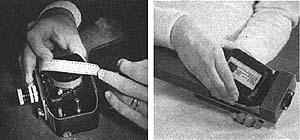
Loading a Regular-8 camera was tricky, and there was a risk that part of the film would be accidentally fogged or even double-exposed. Both Super-8 and Single-8, on the other hand, had simple drop-in loading.
8 mm (both Regular and Super) was cheap enough so that you could afford to buy ready-made films in larger quantities. Many Chaplin films (and other silent era comedys) became available in black and white, and Disney, MGM and WB cartoons were available both in black and white and color, sometimes with sound on a magnetic stripe on the film. These movies were often printed on 16, 32 or 35 mm laboratory stock, perforated with 8 mm sprocket holes, and slit to 2 or 4 prints after developing.
Super-8 was manufactured by Kodak and some others, Single-8 by Fuji exclusively. The only difference was the shape of the cartridge (which precluded one film from being used in the other manufacturer's cameras - again!), and the fact that Fuji's film was polyester-based. The Fuji film practically never broke, but it couldn't be spliced in the usual way with film cement. Only tape splices could be used. However, the same projector could show both Super-8 and Single-8, and there were even models that could be adapted to use the old Regular-8 size as well, by changing a few components, or by just flipping a lever. All 8 mm formats could also be used for sound movies, by adding a magnetic track to the edge of the film.
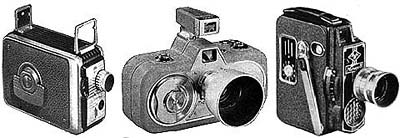
Three Regular-8 cameras: The simple, inexpensive Kodak, with a fold-up viewfinder; The exquisite Zeiss Movikon with horizontal film loading, and an Agfa model, unique in that it used pre-slit Regular-8 film.
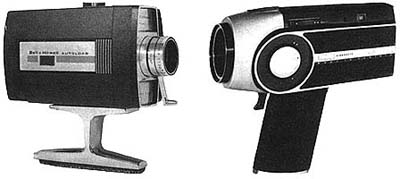
Two Super-8 cameras introduced in 1965: Bell&Howell's "Autoload" with its distinctive handgrip (the release button, thumb-operated, is on the back of the handle), and the Eumig Viennette with its "futuristic" design, so typical of the 1960s.
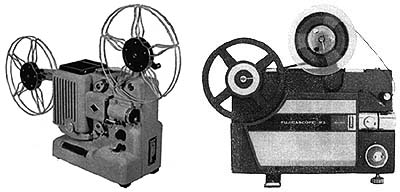
Left: A typical Regular-8 projector, this one by Eumig. Right: Fuji's "Fujicascope M3" was unique in the respect that it could project all three 8mm formats, Regular-8, Super-8 and Single-8, with no intervention from the operator, even spliced together on the same reel!
Many other formats were tried and used for short periods of time. One of the most curious (by the German R. Thun) used 20 parallell rows of minuscle pictures on 35 mm film! There were stereoscopic formats, where the film moved diagonally through the camera, wide screen formats on 35 mm, 16 mm and 8 mm, etc. Some processes used black and white film with special cameras and filters to produce color images (see the "The American Wide Screen Museum's" section about old color processes!).
Here are a few more of the curious formats used in the early decades of this century:
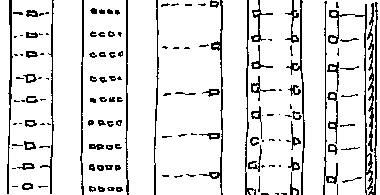
11mm, USA 1916; 13mm with 4 rows of perforations, France 1925; 26mm, France 1920; 18mm, Russia 1925; 17mm with optical sound track, France 1930
The narrowest format I'm aware of is 3mm, enlarged approx. 2X below:
![]()
This format was used by the US Air Force in the 1960's. It was slit from wider material, center perforated, and loaded into cameras on prototype fighter airplanes for documenting aircraft performance. This format made it possible to film a whole test flight with a single load of film - changing the film in the middle of an intricate air maneuver would have been slightly awkward...
A 4mm format (sometimes anticipated in science-fiction literature, before the writers could foresee video recording - as in Arthur C. Clarke's "Childhood's End") would have been a natural consequence of the "halving principle", but it never appeared, to my knowledge.
In the early 1960's, as the Super-8 format was planned, some designers suggested that a completely new format, 10.5mm, should be developed as a replacement for the 16mm film that had become very popular in education. Classroom films were bought by many schools, but the high cost of 16mm prints prevented schools from establishing large film libraries. It was felt that 8mm (even the planned Super-8) was inadequate for this use.
However, the 10.5mm format never got further than the test phase, which indeed provided high quality. So Super-8 became the new low-cost alternative. 15 years later, video had almost completely replaced film in educatiunal use - and in five more years, in 1985 or so, the sale of amateur film equipment diminished to a trickle.
The 8 mm technology had reached its apex in the early 1980's with sound-on-film cameras, superspeed lenses, and films for extremely low light levels - you could even get images in candlelight! Today, hardly anyone uses 8 mm or 16 mm, or any film at all to shoot their home movies, for that matter - electronic imaging with CCD cameras and storage on magnetic tape has taken over.
Unfortunately, since video tape is so cheap (you get up to 10 hours of tape for the price of a single 3-minute 8 mm cassette!), few people ever bother to learn how to use their cameras properly - learn that it is the subject that should move, not the camera - learn to use the zoom lens only for framing the scene, not to pump back and forth with - learn to use a tripod - learn to pan the camera only when necessary and without jerks, etc. etc...
No consumer video gear can yet shoot frame-by-frame, an absolute necessity for making animated films (some do shoot 4-frame snippets, but that's not good enough for proper, smooth animation).
Another drawback of the video camcorder is this: Years ago, friends invited you to their house to watch a roll of 8 mm film of their baby - 3 or 4 minutes; Yes, thank you. Today, you get invited to watch the new baby on video - shaky, blurred pictures by the cassetteful; 3 or 4 hours each... No thanks! ;-)
This is only a partial study of many of the sometimes rather weird sizes and perforation types used. If you have info about any others, especially old pictures of cameras and films, please e-mail me!
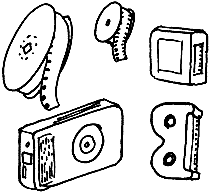
Film spools and cassettes for 16 mm
The improvement in image area when moving from R-8 to S-8 was not that great, compared with the 9.5mm and 16mm formats.
and 8 mm cameras, clockwise from top:
Regular-8 (also called Double-8) spool,
Kodak Super-8 type cassette,
Fuji "Single-8" cassette,
50 ft (15 m) 16 mm magazine,
16 mm, 100 ft (30 m) daylight loading spool.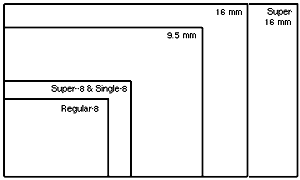
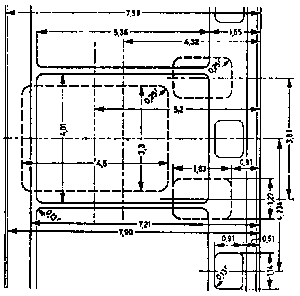
Here is a comparison between the Regular-8 (dashed lines) and Super-8 frames & perforations (solid lines).
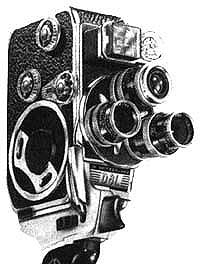
The Bolex D8L, a jewel of Regular-8 engineering.
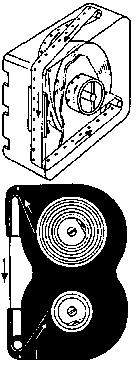
The difference in cassette design between Super-8 and Single-8 enabled Single-8 users to rewind the film, shoot at higher speeds, and Fuji's design had the pressure plate in the camera instead of in the cassette, which improved the picture steadiness & sharpness.
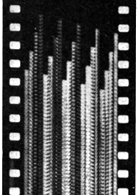
The Thun "Row-film", 20 rows of images on 35mm film.
A few home movie formats did not use regular film, but recorded the images in a spiral on a disc, sometimes combining phonograph sound with the pictures. Shown are parts of two such disks: Kinematograph, Canada 1904 and Spirograph, USA 1914. The Spirograph viewer below belongs to a Finnish collection of19th century optical entertainment equipment.
This is my first movie camera, an Eumig Regular-8, first made in the late 1930's. I bought it second hand in 1967, just as Super-8 hit the market. A few years after that, Regular-8 was already dying...
If you own an old Regular-8 mm (or even Super-8 mm) camera, you own a piece of motion picture history! |
